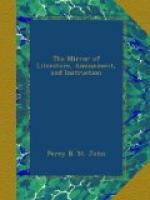The ancients are said to have buried their dead in their own houses, whence, according to some, the original of that species of idolatry consisting in the worship of household gods.
The place of burial amongst the Jews was never particularly determined. We find that they had burial-places upon the highways, in gardens, and upon mountains. We read, that Abraham was buried with Sarah, his wife, in the cave of Macphelah, in the field of Ephron, and Uzziah, King of Judah, slept with his fathers in the field of the burial which pertained to the kings.
The primitive Greeks were buried in places prepared for that purpose in their own houses; but in after ages they adopted the judicious practice of establishing the burial grounds in desert islands, and outside the walls of towns, by that means securing them from profanation, and themselves from the liability of catching infection from those who had died of contagious disorders.
The Romans prohibited burning or burying in the city, both from a sacred and civil consideration, that the priests might not be contaminated by touching a dead body, and that houses might not be endangered by the frequency of funeral fires.
The custom of burning the dead had its foundation laid deep in nature: an anxious fondness to preserve the great and good, the dear friend and the near relative, was the sole motive that prevailed in the institution of this solemnity. “That seems to me,” says Cicero, “to have been the most ancient kind of burial, which, according to Xenophon, was used by Cyrus. For the body is returned to the earth, and so placed as to be covered with the veil of its mother.” Pliny also agrees with Cicero upon this point, and says the custom of burial preceded that of burning among the Romans. According to Monfaucon, the custom of burning entirely ceased at Rome about the time of Theodorius the younger. When cremation ceased on the introduction of Christianity, the believing Romans, together with the Romanized and converted Britons, would necessarily, as it is observed by Mr. Grough, “betake themselves to the use of sarcophagi (or coffins,) and probably of various kinds, stone, marble, lead,” &c. They would likewise now first place the body in a position due east and west, and thus bestow an unequivocal mark of distinction between the funeral deposit of the earliest Roman inhabitants of this island, and their Christian successors. The usual places of interment were in fields or gardens,[4] near the highway, to be conspicuous, and to remind the passengers how transient everything is, that wears the garb of mortality. By this means, also, they saved the best part of their land:
—Experiar quid concedatur in
illos
Quorum Flaminia tegitur cinis, atque Latina.
Juv.
Sat I.
The Romans commonly built tombs for themselves during their lifetime. Hence these words frequently occur in ancient inscriptions, V.F. Vivus Facit, V.S.P. Vivus Sibi Posuit. The tombs of the rich were usually constructed of marble, the ground enclosed with walls, and planted round with trees. But common sepulchres were usually built below ground, and called hypogea. There were niches cut out of the walls, in which the urns were placed: these, from their resemblance to the niche of a pigeon-house, were called columbaria.




